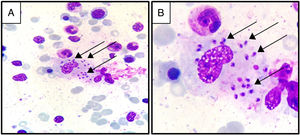A 50-year-old man came to the emergency room of a university hospital complaining of weight loss, fever and abdominal pain associated with hepatosplenomegaly. Laboratory investigations revealed pancytopenia with red blood cell (RBC) count of 2.35×1012/L, hemoglobin 7.2g/dL (RBCs with rouleaux formation), platelets of 75.7×109/L, white blood cell count of 2.77×109/L (with 58% neutrophils, 27% lymphocytes, 15% monocytes, 0% eosinophils and 0% basophils), hypoalbuminemia (1.31g/dL) and hypergammaglobulinemia (6.63g/dL). Serological test results were negative for antibodies for hepatitis (B and C) and human immunodeficiency virus (HIV). Due to the laboratory findings and sustained pancytopenia, a bone marrow biopsy was performed which showed Leishmania amastigotes phagocytosed by macrophages (Figure 1) confirming the diagnosis of visceral leishmaniasis infection.1,2
O fator de impacto mede o número médio de citações recebidas em um ano por trabalhos publicados na revista durante os dois anos anteriores.
© Clarivate Analytics, Journal Citation Reports 2025
O CiteScore mede as citações médias recebidas por documento publicado. Mais informação
Ver maisSJR é uma métrica de prestígio baseada na idéia de que todas as citações não são iguais. SJR utiliza um algoritmo similar ao page rank do Google; é uma medida quantitativa e qualitativa ao impacto de uma publicação.
Ver maisSNIP permite comparar o impacto de revistas de diferentes campos temáticos, corrigindo as diferenças na probabilidade de ser citado que existe entre revistas de distintas matérias.
Ver mais







